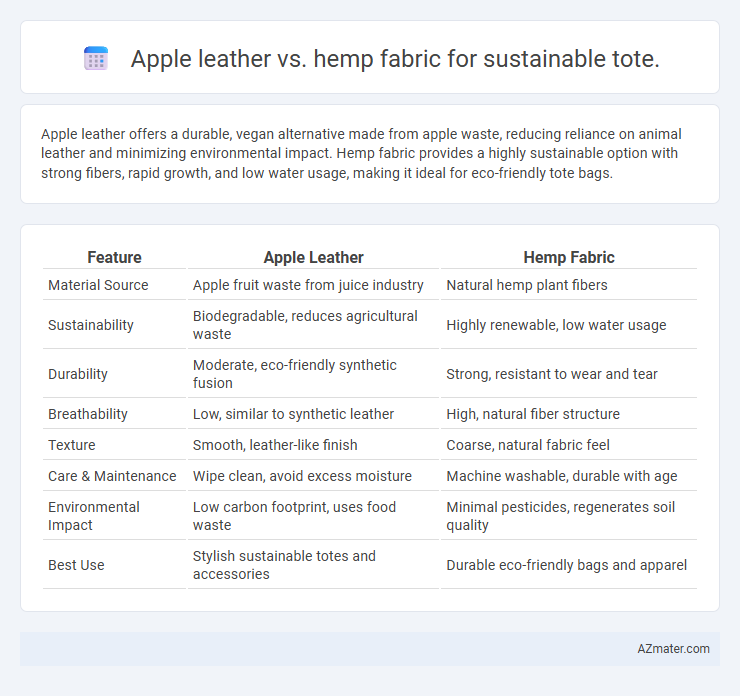Apple leather offers a durable, vegan alternative made from apple waste, reducing reliance on animal leather and minimizing environmental impact. Hemp fabric provides a highly sustainable option with strong fibers, rapid growth, and low water usage, making it ideal for eco-friendly tote bags.
Table of Comparison
| Feature | Apple Leather | Hemp Fabric |
|---|---|---|
| Material Source | Apple fruit waste from juice industry | Natural hemp plant fibers |
| Sustainability | Biodegradable, reduces agricultural waste | Highly renewable, low water usage |
| Durability | Moderate, eco-friendly synthetic fusion | Strong, resistant to wear and tear |
| Breathability | Low, similar to synthetic leather | High, natural fiber structure |
| Texture | Smooth, leather-like finish | Coarse, natural fabric feel |
| Care & Maintenance | Wipe clean, avoid excess moisture | Machine washable, durable with age |
| Environmental Impact | Low carbon footprint, uses food waste | Minimal pesticides, regenerates soil quality |
| Best Use | Stylish sustainable totes and accessories | Durable eco-friendly bags and apparel |
Introduction to Sustainable Tote Materials
Apple leather and hemp fabric represent innovative sustainable tote materials combining eco-friendly production with durability. Apple leather, derived from apple waste, reduces reliance on animal leather while offering a biodegradable alternative with a unique texture. Hemp fabric, known for its rapid growth and minimal pesticide use, provides a strong, breathable, and biodegradable option ideal for sustainable fashion.
What is Apple Leather?
Apple leather is a sustainable, eco-friendly material made from the waste of apple processing, such as apple peels and cores, transformed into a durable, vegan leather alternative. This innovative material reduces reliance on traditional animal leather and synthetic options by utilizing fruit waste, resulting in lower carbon emissions and less environmental impact. Compared to hemp fabric, apple leather offers a smooth, leather-like texture while maintaining biodegradability and supporting circular economy principles in sustainable tote production.
Understanding Hemp Fabric
Hemp fabric offers exceptional durability and breathability, making it a highly sustainable choice for tote bags due to its rapid growth cycle and minimal water requirements. Unlike Apple leather, which is a byproduct of fruit waste processing, hemp is a natural fiber that provides superior biodegradability and requires fewer pesticides, reducing environmental impact. Its strong fibers ensure long-lasting use, positioning hemp fabric as an eco-friendly alternative in sustainable fashion and accessories.
Environmental Impact: Apple Leather vs Hemp
Apple leather production utilizes byproducts from the apple juice industry, reducing fruit waste and requiring less water compared to traditional leather, making it a low-impact, biodegradable alternative. Hemp fabric, known for its fast growth and minimal pesticide needs, offers a highly sustainable textile with excellent carbon sequestration properties and soil regeneration benefits. While apple leather reduces organic waste and resource use, hemp fabric contributes significantly to soil health and carbon capture, presenting distinct but complementary environmental advantages for sustainable tote bags.
Durability and Longevity Comparison
Apple leather offers notable durability with its dense texture and resistance to wear, making it ideal for long-lasting sustainable totes. Hemp fabric boasts exceptional tensile strength and natural resistance to abrasion, ensuring enhanced longevity through repeated use and washing. Both materials surpass many traditional fabrics in lifespan, with hemp typically providing superior durability in rugged conditions and apple leather excelling in maintaining aesthetic appeal over time.
Aesthetic and Texture Differences
Apple leather offers a smooth, supple texture with a refined, polished aesthetic that mimics traditional leather's luxury and durability. Hemp fabric presents a coarse, natural texture characterized by its organic, rustic appearance and breathable quality. Both materials provide distinctive visual and tactile experiences, with apple leather appealing to a sleek, modern style while hemp fabric celebrates an earthy, eco-friendly vibe.
Production Processes and Sustainability
Apple leather is crafted from upcycled apple waste combined with non-toxic binders, significantly reducing reliance on animal hides and synthetic leathers, while requiring less water and energy during production. Hemp fabric is cultivated with minimal pesticides and fertilizers, thriving in diverse climates and regenerating soil health, producing a strong, biodegradable textile with a low carbon footprint. Both materials represent eco-conscious choices, yet hemp's renewable cultivation contrasts with apple leather's innovative use of agro-industrial byproducts, highlighting different paths toward sustainable tote production.
Cost Analysis: Apple Leather vs Hemp
Apple leather typically incurs higher production costs due to its innovative processing methods and limited-scale manufacturing, which impacts the overall price of sustainable tote bags. Hemp fabric benefits from established agricultural practices and efficient fiber extraction, resulting in lower raw material and processing expenses that make hemp totes more cost-effective. Comparing durability and longevity, apple leather totes may justify their premium through unique aesthetic appeal, while hemp fabric totes offer affordability and practicality for eco-conscious consumers.
Consumer Preferences and Market Trends
Apple leather and hemp fabric emerge as leading materials in the sustainable tote market, reflecting a growing consumer preference for eco-friendly and ethically sourced products. Apple leather, derived from apple waste, appeals due to its biodegradable qualities and luxurious texture, while hemp fabric attracts consumers with its durability, breathability, and low environmental impact. Market trends indicate rising demand for plant-based and natural fibers, positioning both materials as popular choices for environmentally conscious shoppers seeking stylish and sustainable alternatives.
Which Material is Better for Sustainable Totes?
Apple leather offers a biodegradable alternative made from apple waste, reducing reliance on synthetic materials and minimizing environmental impact. Hemp fabric provides exceptional durability, natural antimicrobial properties, and requires significantly less water and pesticides compared to cotton, making it an eco-friendly choice. In terms of sustainability, hemp fabric has the advantage due to its renewable growth cycle and lower resource consumption, but apple leather stands out for its innovative use of food industry byproducts.

Infographic: Apple leather vs Hemp fabric for Sustainable tote
 azmater.com
azmater.com